View from the Hill 10th August 2017
My apologies to regular readers for this month’s tardiness.
A victim of the stop start harvest in between incessant rain storms, this loader tractor’s transmission died mid load, trying to get all the bales picked up before the next downpour. This was our contractor’s team at work on Shillingstone Hill, with majestic Hambledon Hill and an angry sky giving an interesting backdrop. The driver noticed some unhealthy noises from under his seat and managed to unhitch the grab and back away before the tractor jumped out of gear and started flashing several lights on the dashboard. No other tractors were available so they came and borrowed our Claas Scorpion handler to finish the evening’s work. On several occasions the baling team have been right on the combine’s tail, such as in this picture, in a desperate bid to get the straw wrapped up before nightfall, and likely more rain. 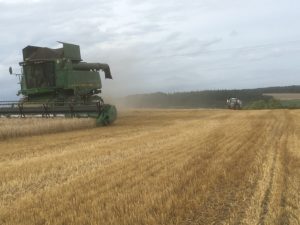
After a great and nearly record early start to harvest on 7th July, the winter barley and most of the rape went swimmingly, with respectable yields. All that seems a long time ago now, we have since struggled through 78 hectares of brackled and challenging spring barley, usually destined for the brewers of Belgium, Holland or France, with 50 ha remaining if it ever dries up. After that there are still 180 ha of wheat and 80 of poppy to gather in. The dry and hot early summer has led to weak straw in the barley and the crop has given up the fight against gravity, meaning that to cut it we need crispy dry conditions, if clammy the straw simply hangs up on the header and won’t flow, some nights we have had to pack up before 8.30, whereas in standing wheat one can often continue into the night. Let us hope that by the time this hits your doormat we will have discovered a sunnier corner of August in which to complete what has turned into a very difficult harvest.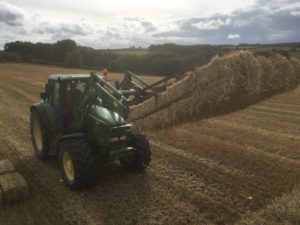
On one of the better days we had action of every kind on the Knoll, the combine and grain cart were busy all day, soon joined by 3 different kinds of baler during the day. The large rectangular ones favoured by our contractor Adam Coleman, who supplies straw into a large dairy farm over near Chard, the round bales we use for our own cattle in winter, and the truly vintage small bales which were designed for manual stacking over 60 years ago. We baled around 150 this year to use on those odd occasions, such as in pheasant pens, and for the skittles competition at Durweston’s village fete.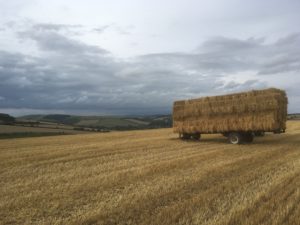
The Knoll is a great field for photos with a view, here it is Hod Hill in the background, just north of Stourpaine. Does anyone remember 2012 when this field was red with wild poppies from side to side? I would rather not, it cost us a great deal in failed crop!
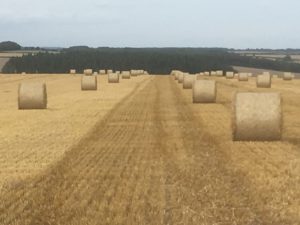 While we have been cursing the weather for harvest reasons, at least the grass has caught up with the demands of the animals, and everywhere looks much greener than it did in late June. The calves and lambs are growing well, punishing their mothers with regular demands for milk, and eating more and more grass as they grow. One wet day the opportunity was taken to worm and vaccinate the lambs, and treat all the sheep to prevent flystrike, (the treatment looks blue for a day or two), and a run through the footbath is always worthwhile too, if we have the sheep in the yard, to ward off footrot, and scald, which can affect the lambs on wet grass.
While we have been cursing the weather for harvest reasons, at least the grass has caught up with the demands of the animals, and everywhere looks much greener than it did in late June. The calves and lambs are growing well, punishing their mothers with regular demands for milk, and eating more and more grass as they grow. One wet day the opportunity was taken to worm and vaccinate the lambs, and treat all the sheep to prevent flystrike, (the treatment looks blue for a day or two), and a run through the footbath is always worthwhile too, if we have the sheep in the yard, to ward off footrot, and scald, which can affect the lambs on wet grass.
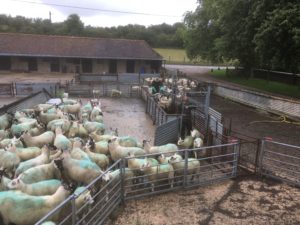 A few weeks ago we received in the post the dreaded notification from DEFRA that one of our neighbours cattle herds has had a bTB (bovine tuberculosis) breakdown. Having thought we would be safe until next spring on our annual testing regime, here in the high risk TB area of the country, if a farm suffers a breakdown, then all those with cattle on neighbouring farms have to prove their animals are not harbouring the disease as well. We had the test a couple of weeks ago, and very annoyingly, out of 60 cows and 60 calves, we had one Inconclusive reactor. This means that the vaccine used for the test has produced a small skin reaction at the injection site, but not sufficient to be deemed a full reactor, this animal will get a second chance in 60 days time. If Inconclusive for a second time, she is deemed a reactor, and will be sent for the chop. If no reaction second time, she can rejoin the herd. In the meantime she is kept in isolation with her calf, looking rather lonely.
A few weeks ago we received in the post the dreaded notification from DEFRA that one of our neighbours cattle herds has had a bTB (bovine tuberculosis) breakdown. Having thought we would be safe until next spring on our annual testing regime, here in the high risk TB area of the country, if a farm suffers a breakdown, then all those with cattle on neighbouring farms have to prove their animals are not harbouring the disease as well. We had the test a couple of weeks ago, and very annoyingly, out of 60 cows and 60 calves, we had one Inconclusive reactor. This means that the vaccine used for the test has produced a small skin reaction at the injection site, but not sufficient to be deemed a full reactor, this animal will get a second chance in 60 days time. If Inconclusive for a second time, she is deemed a reactor, and will be sent for the chop. If no reaction second time, she can rejoin the herd. In the meantime she is kept in isolation with her calf, looking rather lonely. 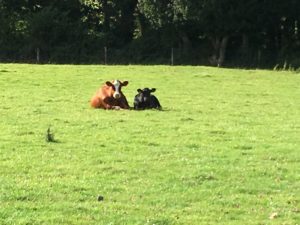 Cattle are social animals, there must be something in their genes regarding safety in numbers, I recall the magnificent TV footage of wildebeest on the move, where isolation of an individual always means trouble. If she has to go, I fear for her calf. He will have to be tested, as will the whole of the rest of the herd, again, and to regain TB free status all will have to pass two 60 day interval tests. Time spent on TB testing means other important work like harvesting has to wait.
Cattle are social animals, there must be something in their genes regarding safety in numbers, I recall the magnificent TV footage of wildebeest on the move, where isolation of an individual always means trouble. If she has to go, I fear for her calf. He will have to be tested, as will the whole of the rest of the herd, again, and to regain TB free status all will have to pass two 60 day interval tests. Time spent on TB testing means other important work like harvesting has to wait.
The government has a 25 year TB eradication policy for the country, which involves a number of approaches, firstly dividing the country into High and Low risk areas for TB, aiming for TB free status in the Low risk areas as soon as possible. The High risk areas, predominantly in the south west and north west, have pretty onerous rules covering testing and movement of all cattle, rightly so, if this cursed disease is to be beaten. What is also allowed for in the high risk areas is for groups of farmers, with veterinary and logistical help and close supervision from Natural England, to apply for a licence to carry out a cull of the wildlife that carries bovine TB. 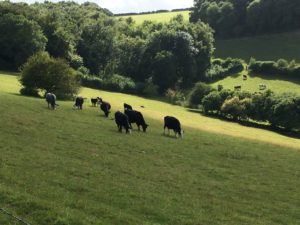 Clear evidence from other countries has shown that a failure to address the disease in wildlife will make it impossible to remove the disease from Britain. Vaccination of badgers and or cattle may have a part to play in this at some point in the future, but it only masks the disease and does not remove it, and the matter of who will pay for the badger treatment would need to be agreed. In the mean time over the last five years, a number of control areas have been set up in the worst affected areas, where early evidence is showing a significant reduction of fresh outbreaks of TB on cattle farms.
Clear evidence from other countries has shown that a failure to address the disease in wildlife will make it impossible to remove the disease from Britain. Vaccination of badgers and or cattle may have a part to play in this at some point in the future, but it only masks the disease and does not remove it, and the matter of who will pay for the badger treatment would need to be agreed. In the mean time over the last five years, a number of control areas have been set up in the worst affected areas, where early evidence is showing a significant reduction of fresh outbreaks of TB on cattle farms.
A couple of days ago our dog got very excited around our garden incinerator, and wouldn’t stop scuffling around it. On close inspection we found that a hedgehog had somehow managed to clamber the 3 foot metal wall of the old 40 gallon drum, and trap itself inside. Thank goodness the dog discovered it before the next bonfire. After a night in a box with a bowl of cat food and a bowl of water, Tiggywinkle was returned to the safety of a hedge bottom outside the garden, seemingly none the worse for his her experience.
More hedgerow action happened a week or so earlier, one morning we discovered a car that had failed to take the bend along the road from the farm, it climbed the verge, clearly at some speed, because it was airborne a full 20 feet before landing in the field beyond, clearing the hedge and fence completely. It’s a good job we had already cut the rape, otherwise the occupants would not have known where on earth they were on landing, it was very tall this year. The owner rather sheepishly called next morning asking if they could bring a tow truck into the field to retrieve the car. 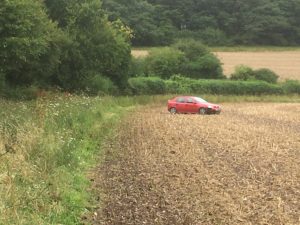
How do fairy rings form? This one has formed within less than ten years, on a grass bank that we formed when we landscaped around the grainstore.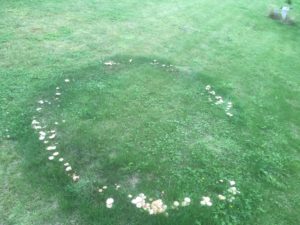
A wise old sage, a friend of the farm for the last 50 years, takes great pleasure in reminding me this week, that the weather will always have the last word….. We forget this at our peril!


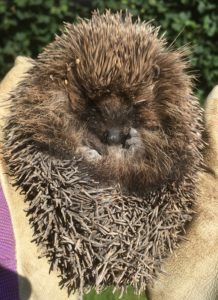
You have my sympathy re this harvest. The constant damp has exasurbated the endemic late tomato blight problem resulting in a more or less wipe out of non resistant Italian plum varieties.
Re- the speeding car: how horrible to think that people are driving in your neighbourhood so stupidly and at such speed. Were you not tempted to report the matter to the police?